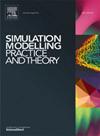采用有限-离散元耦合方法对封闭充填岩体预裂爆破进行数值研究
IF 3.5
2区 计算机科学
Q2 COMPUTER SCIENCE, INTERDISCIPLINARY APPLICATIONS
引用次数: 0
摘要
岩体爆破的优化性能在很大程度上依赖于不连续面的存在。这些地质特征对岩石中的波和裂缝传播起着重要作用,可以被认为是阻止爆炸波和裂缝传播的屏障。爆破有许多应用,其中一个重要的方面是预裂爆破,在主爆破之前进行轻爆以形成一个连续的平面。这种特殊爆破作业的目的主要是抑制对储备岩石的破坏。在地下岩石预裂爆破中,地应力的大小起着至关重要的作用,它决定着预裂爆破的性能,如果测量不当可能导致爆轰不成功。有很多证据表明,在许多情况下,关节并没有闭合,而是被不同的材料填充。因此,在本研究中,采用结合裂隙内气体逻辑的有限-离散单元法(FDEM)对具有闭合或充填节理的岩石域中的预裂爆破性能进行了分析。首先,通过实验验证了该方法的适用性。验证后,分析二维FDEM模型,以评估倾斜闭合或填充缺陷对爆致裂缝发育的影响。FDEM结果证实节理倾角对破碎程度的影响较大。此外,研究表明,预裂爆破的效果与地应力的大小有显著的关系。结果还表明,充填材料及其相对于最大主应力的取向角对预裂爆破的成功与否有重要影响。结果表明,在填缝预裂爆破中,填缝破坏为模态破坏,连接裂缝为拉伸破坏。本文章由计算机程序翻译,如有差异,请以英文原文为准。
Numerical study of presplit blasting in rock masses with a closed and filled joint using coupled finite-discrete element method
The optimized performance of rock blasting heavily relies on the presence of discontinuities. These geological features play an important role in wave and fracture propagation in rocks and can be considered a barrier against the blast wave and fracture propagation. Blasting has many applications, but one of the important aspects is presplitting blasting, in which light blasts are operated to create a continuous plane prior to the main blasting. The goal of this particular blast operation is mainly to inhibit damage to the reserved rock. In the presplit blastingin underground rocks, the magnitude of the ground in-situ stresses plays a vital role and dominates the performance of the presplitting, which can lead to an unsuccessful detonation if mismeasured. There is much evidence that, in many cases, the joints are not closed but instead are filled with a different material. Thus, in this study, the performance of presplit blasting in a rock domain with a closed or filled joint is analysed using the combined finite-discrete element method (FDEM) with a gas in fracture logic. First, the applicability of the method is verified against some experiments. Once verified, 2D FDEM models are analysed to evaluate the influence of an inclined closed or filled flaw on blast-induced fracture development. The FDEM results confirm the strong impact of joint inclination angle on the fragmentation degree. Furthermore, it is shown that the performance of the presplit blasting is remarkably dependent on the magnitude of ground in-situ stresses. The results also show that the filling material and its orientation angle with respect to the maximum principal stress have an imposing effect on the success of the presplitting blasting. Also, it is revealed that in the presplit blasting with filled joint, the failure of the filling is a mode failure, while the connecting fractures are of tensile mode.
求助全文
通过发布文献求助,成功后即可免费获取论文全文。
去求助
来源期刊

Simulation Modelling Practice and Theory
工程技术-计算机:跨学科应用
CiteScore
9.80
自引率
4.80%
发文量
142
审稿时长
21 days
期刊介绍:
The journal Simulation Modelling Practice and Theory provides a forum for original, high-quality papers dealing with any aspect of systems simulation and modelling.
The journal aims at being a reference and a powerful tool to all those professionally active and/or interested in the methods and applications of simulation. Submitted papers will be peer reviewed and must significantly contribute to modelling and simulation in general or use modelling and simulation in application areas.
Paper submission is solicited on:
• theoretical aspects of modelling and simulation including formal modelling, model-checking, random number generators, sensitivity analysis, variance reduction techniques, experimental design, meta-modelling, methods and algorithms for validation and verification, selection and comparison procedures etc.;
• methodology and application of modelling and simulation in any area, including computer systems, networks, real-time and embedded systems, mobile and intelligent agents, manufacturing and transportation systems, management, engineering, biomedical engineering, economics, ecology and environment, education, transaction handling, etc.;
• simulation languages and environments including those, specific to distributed computing, grid computing, high performance computers or computer networks, etc.;
• distributed and real-time simulation, simulation interoperability;
• tools for high performance computing simulation, including dedicated architectures and parallel computing.
 求助内容:
求助内容: 应助结果提醒方式:
应助结果提醒方式:


